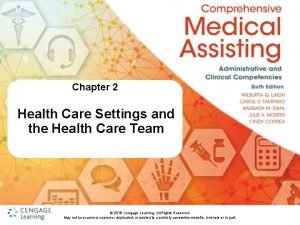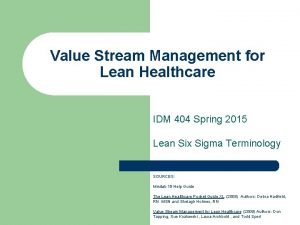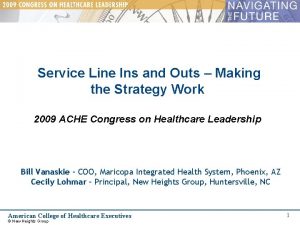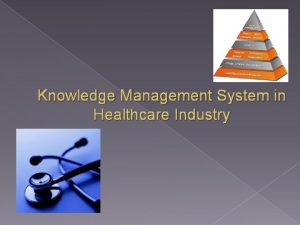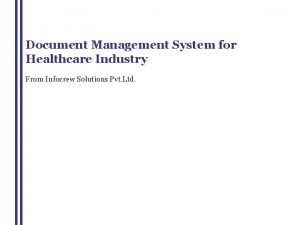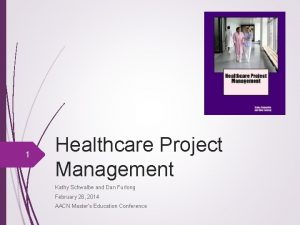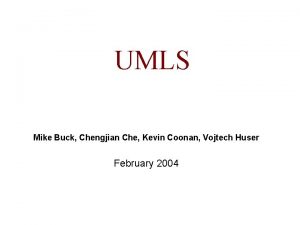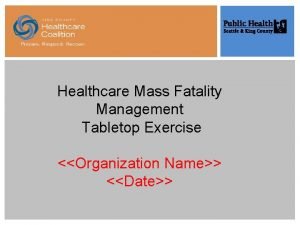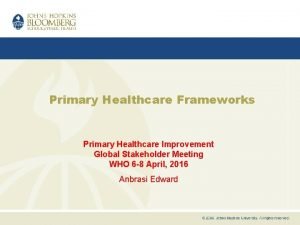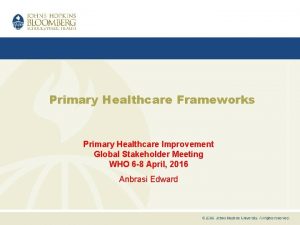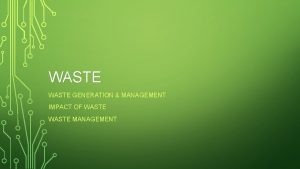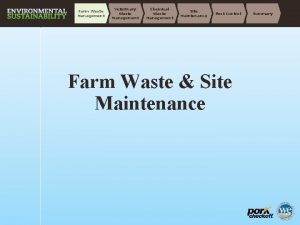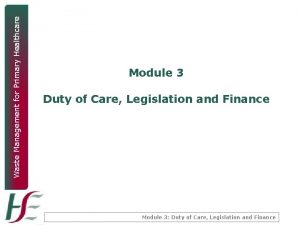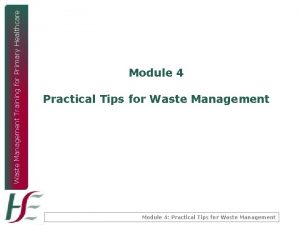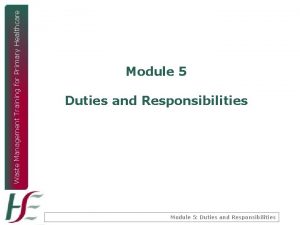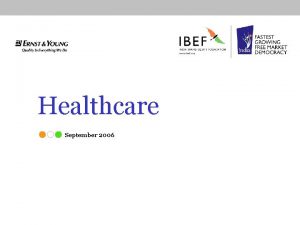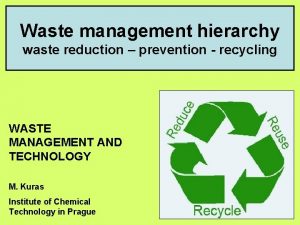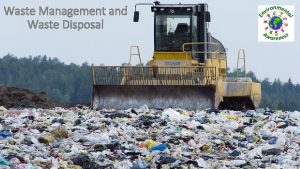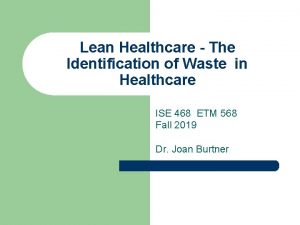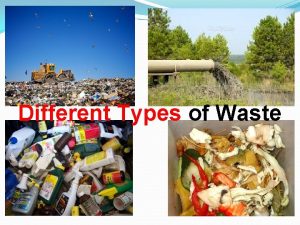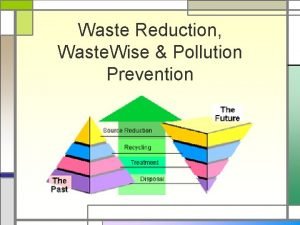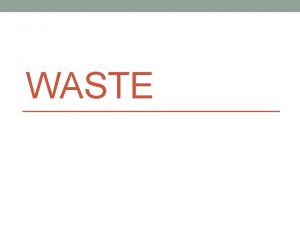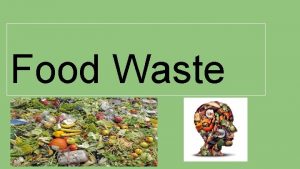Waste Management for Primary Healthcare WASTE MANAGEMENT FOR





































- Slides: 37

Waste Management for Primary Healthcare WASTE MANAGEMENT FOR PRIMARY HEALTHCARE Module 1: Introduction

Waste Management for Primary Healthcare This course is designed… • To provide a waste management training course targeted at the primary healthcare sector • To broadly address the legislative waste management requirements • Practical requirements for waste management • To provide an insight /greater knowledge of waste management and…. • It’s not just about ‘risk’ waste Module 1: Introduction

Waste Management for Primary Healthcare Why the Training? • Report by the Office of the Comptroller and Auditor General in March 2005, Value for Money Examination 49: Waste Management in Hospitals – Despite the increasing costs and the challenges involved in the proper management of hospital waste, very little information was readily available about the volumes of waste generated in Irish hospitals, or about the costs to the health service of handling and disposal of waste. – Some useful information was available about risk waste, but less known about the management of non-risk waste in Irish hospitals. Module 1: Introduction

Waste Management for Primary Healthcare Agenda • Module 1: Introduction • Module 2: Waste Management Overview • Module 3: Duty of Care, Legislation and Finance • Module 4: Practical Tips for Waste Management • Module 5: Duties and Responsibilities Module 1: Introduction

Waste Management for Primary Healthcare Objectives of this Course 1. To provide a waste management training course targeted at the primary healthcare sector 2. To highlight the environmental and waste issues of most relevance to the healthcare sector in Ireland 3. To address legislative waste management requirements 4. To emphasise that Managers and healthcare facilities have responsibility for waste generated at their own premises under waste management legislation 5. To appreciate the financial benefits of proper waste management systems 6. To examine the practical steps required for the management and recycling of healthcare waste 7. Practical advice on setting up a waste records management and tracking system and associated benefits 8. Sharing knowledge with all staff – training and communication Module 1: Introduction

Waste Management for Primary Healthcare Module 1 Introduction Module 1: Introduction

Waste Management for Primary Healthcare 1. 1 Background • Training programme in Healthcare Waste Management for Healthcare Personnel – Developed by the Health Service Executive (HSE) • Comprehensive programme for training Healthcare Personnel on waste management associated with the Healthcare sector • Provides practical waste management advice to manage, reduce, reuse and recycle healthcare institution generated waste Module 1: Introduction

Waste Management for Primary Healthcare (2) Waste Management and the Healthcare Sector • Increasingly important to establish a correct system for waste management • Primary healthcare facilities merit special attention as the number of people receiving primary care is significant and increasing • Impacts on waste generation & waste management Module 1: Introduction

Waste Management for Primary Healthcare 2. 1 Waste Types • Majority of waste is non-risk – Paper, cardboard, packaging, textiles, paper towels, glass and newspapers/magazines • Approx. 20% is classified as risk waste – sharps, general risk waste such as items soiled with blood or other body fluids and pharmaceutical waste • Only the correct waste should be disposed of in the specialised containers due to significant cost differences • Also for health and safety reasons risk waste should not be mixed with non-risk waste Module 1: Introduction

Waste Management for Primary Healthcare 2. 3 Waste Handling • Risk waste has the largest environmental and health and safety concern • High threat of infection and therefore it cannot be recycled • Must be disposed of correctly to prevent infection • Risk waste generally brought to a facility in Ireland where it undergoes disinfection treatment followed by disposal to landfill • A small fraction is not suitable for disinfection and is sent to mainland Europe for treatment Module 1: Introduction

Waste Management for Primary Healthcare (3) Healthcare Waste Management – what are the issues? Module 1: Introduction

Waste Management for Primary Healthcare 3. 1 Health and Safety • Primary issue for anyone who may come into contact with waste from a healthcare facility • Potentially hazardous or infectious material • Correct segregation and handling procedures can reduce the associated risk • Risks involved 1. Cross-contamination of waste types 2. Injuries from materials not disposed of correctly 3. Fines/imprisonment for the illegal disposal of healthcare risk waste • Training staff is vital to minimise risk involved with dealing with healthcare waste Module 1: Introduction

Waste Management for Primary Healthcare 3. 1 Health and Safety • Training should be given at two stages: – Induction • All staff members should be informed of the current waste management practices at the facility. • Ensure that source separation is carried out effectively • Help to cut down on any unintentional cross-contamination. – Change of Practice in Waste Management Procedures • All staff should be trained to deal with the waste they will encounter • Training can be organised internally or externally Module 1: Introduction

Waste Management for Primary Healthcare 3. 2 Waste Management Costs and Financial Savings • Waste management costs generally are acknowledged as a significant business cost • Primary healthcare facilities - ensure that only risk waste which requires specialist handling and treatment is directed to the risk waste management route • Not only are there environmental issues to consider, but there also very substantial cost differentials Module 1: Introduction

Waste Management for Primary Healthcare 3. 2 Waste Management Costs and Financial Savings • “Yellow bag” waste is very expensive to dispose of – some indicative costs are shown below (these costs will vary over time, with geography, and may be tonnage-related): Indicative cost per tonne Yellow bags Yellow Bins w/ purple black lids € 900 € 2, 048 Black bags € 130 - € 250 Recyclables € 70 - € 98 Module 1: Introduction

Waste Management for Primary Healthcare 3. 2 Waste Management Costs and Financial Savings • How are your Waste Management Costs Calculated? • Three costs bases – Collection of waste – Segregation/processing costs – Disposal/Recycling/treatment costs Module 1: Introduction

Waste Management for Primary Healthcare 3. 2 Waste Management Costs and Financial Savings Collection Costs • Costs incurred by the waste contractor for transportation and personnel • Waste contractors operate there own vehicles but may also subcontract to haulage companies who are permitted to transport waste • Transportation cost will generally be included in the cost per load/bin Module 1: Introduction

Waste Management for Primary Healthcare 3. 2 Waste Management Costs and Financial Savings Segregation/Processing Costs • Relates to costs incurred between the material arriving at the waste facility and leaving in the suitable marketable product or material for disposal to landfill. • processing usually occurs at a MRF – Materials Recovery Facility. • Mixed material will be separated using a number of different processes including tromelling, magnets and hand-sorting. Module 1: Introduction

Waste Management for Primary Healthcare 3. 2 Waste Management Costs and Financial Savings Disposal/Recycling Costs • The waste contractor then needs to find a suitable market for the recyclable materials. • The residual waste (the fraction remaining after sorting and segregation) must be sent to landfill. • Due to the high cost of landfilling in Ireland, the waste contractor’s goal will usually be to maximise segregation of mixed materials for recycling and to maintain the residual fraction to a minimum. • The money saved by the waste contractor in diverting material away from a landfill is known as the AVOIDED DISPOSAL COST. Module 1: Introduction

Waste Management for Primary Healthcare Costs of Waste Management • Waste contractor service charges • Wasted materials • Storage - renting containers and compactors • Labour • Associated insurance costs • Transport and disposal • Government levies (Landfill levy € 40/tonne at present) The Iceberg Model of the Costs of Waste Module 1: Introduction

Waste Management for Primary Healthcare 3. 3 Landfill Diversion Targets • Not possible to recycle all components of healthcare waste • Certain fraction will need to be pre-treated and the residual sent to landfill • There is a need to divert greater amounts of non-risk waste and recyclables away from landfill • If other forms of treatment are utilised such as recycling, it is hoped that there will be reduced demand for landfill – increasing sustainability – reducing waste management charges Module 1: Introduction

Waste Management for Primary Healthcare 3. 4 Illegal Disposal • A number of high-profile illegal landfill sites have been discovered in Ireland • A range of legislation was introduced to help reduce the amount of illegal dumping • All individuals, companies or partnerships involved in the collection of waste for commercial purposes must have – a Waste Collection Permit authorised by the relevant local authority and – the waste facility must be licensed by the EPA Module 1: Introduction

Waste Management for Primary Healthcare 3. 5 Risk Management Health Risks from Healthcare Waste • Main groups at risk – Waste workers – Patients in health-care settings – Medical & healthcare professionals – Workers engaged in clean up operations and at waste disposal facilities – Workers in support services such as laundry, maintenance, waste handling and transportation – Contractors, volunteers, attending clinicians, students – Visitors to health-care settings Module 1: Introduction

Waste Management for Primary Healthcare 3. 5 Risk Management • Characteristics of hazardous healthcare waste Pathogens in infectious waste may enter the body via: – contains infectious agents – contains toxic or hazardous chemicals or pharmaceuticals – radioactive – contains sharps • Through a puncture, abrasion or cut in the skin (e. g. : HIV, Hepatitis…). • Through the mucous membranes (e. g. : Anthrax, skin infections…) • By inhalation (e. g. : respiratory infections…) • By ingestion (e. g. : Gastroenteric infections…. ) Module 1: Introduction

Waste Management for Primary Healthcare 3. 5 Risk Management Managing Risk • Protective clothing • Hand washing and disinfection • Protection of water bodies • Vaccinations for waste handlers (e. g. Hep B, Influenza, MMR) Module 1: Introduction

Waste Management for Primary Healthcare 3. 5 Risk Management Environmental Risks associated with Waste • Environmental risks must be considered • Healthcare waste must be – Managed correctly at the healthcare facility – Transported safely and directly to an appropriate facility Module 1: Introduction

Waste Management for Primary Healthcare 3. 5 Risk Management • Inappropriate waste management could result in the following liabilities: – Illegal waste disposal/fly-tipping – Contamination of water and groundwater associated with inappropriate disposal – Issues associated with confidential waste not being destroyed – Risks to waste management operatives, e. g. in Materials Recovery Facilities, associated with the incorrect packing of wastes – Remediation of sites contaminated by healthcare waste – Long-term management and aftercare of healthcare risk waste disposal facilities – Contamination of land/waterways from aqueous emissions or spillages Module 1: Introduction

Waste Management for Primary Healthcare 3. 5 Risk Management • ‘Environmental liability’ is based on the "polluter pays principle” – i. e. operators whose activities cause environmental damage will be financially liable for remedying this damage. • Environmental incidents or exposure are likely to have negative impacts on insurance costs and premiums • Healthcare facilities should engage in an increased level of prevention to avoid an environmental incident Module 1: Introduction

Waste Management for Primary Healthcare 3. 6 Government policy and waste management targets Waste Hierarchy • Waste prevention is regarded as the ‘most favoured option’ for managing waste, as indicated in the ‘Hierarchy’ of waste management options below. • The ‘Waste Hierarchy’ has been adopted as Irish National Policy. Module 1: Introduction

Waste Management for Primary Healthcare 3. 6 Government policy and waste management targets EU Landfill Directive (1999/31/EC) • Objective is to prevent or reduce as far as possible the negative effect on the environment from the landfilling of waste • Intended to reduce the adverse effects of landfill on the environment particularly in relation to protection of ground water, soil and air • Landfills must be licensed and hold a valid permit • Targets for landfill diversion, e. g. food waste Module 1: Introduction

Waste Management for Primary Healthcare 3. 6 Government policy and waste management targets National Strategy on Biodegradable Waste (Do. EHLG, April 2006) • Established targets to be met under the Directive • Sets out measures aimed at separate collection, recovery and recycling of biodegradable materials over the next 10 -15 years • By 2016 – Recycling (principally of paper and cardboard waste which cannot be reused) will divert 875, 371 tonnes – Biological treatment (mainly food and garden waste): 442, 129 tonnes – Thermal treatment diverting 499, 762 tonnes of residual waste Module 1: Introduction

Waste Management for Primary Healthcare 3. 7 HSE Waste Policy • Mission Statement “The Health Services Executive is committed to maintaining a waste management system that is safe, efficient, cost effective and respectful of the environment” • Aims – To protect public health & safety. – To provide a safe working environment for staff. – To minimise the environmental impact of waste generation, transport, treatment & disposal. – Reduce waste handling & disposal volumes and costs without compromising health care standards. Module 1: Introduction

Waste Management for Primary Healthcare 3. 7 HSE Waste Policy • Objectives: – Foster commitment from all staff and management to actively participate in: 1. Waste avoidance 2. Waste reduction 3. Waste reuse 4. Waste recycling programs – To comply with Environmental, Safety and Welfare legislation and Policies – To adopt and implement the Waste Management Policy throughout the HSE – To monitor performance and review Waste Management practices at least annually Module 1: Introduction

Waste Management for Primary Healthcare 3. 7 HSE Waste Policy • Objectives: – Develop practical guidelines for : 1. Waste minimisation 2. Use of returnable packaging 3. Re-usable products 4. Recycling equipment within purchasing guidelines – Introduce a continuing waste management education program for all staff to increase awareness of Occupational Health & Safety issues and waste minimisation principles. – Adopt policies and procedures to minimise the environmental impact of waste treatment and disposal. Module 1: Introduction

Waste Management for Primary Healthcare 3. 8 Environmental Sustainability – Sustainability a high profile subject in all sectors and is a key issue for the waste manager in the healthcare facility. – By changing the way in which healthcare facilities deal with their waste they can become more environmentally sustainable. – Source segregation, reduction and recycling of nonrisk waste and correct and appropriate segregation of risk waste can go along way to ensuring the environmental sustainability of a primary healthcare facility. Module 1: Introduction

Waste Management for Primary Healthcare In summary 1. 2. 3. 4. Managing H&S around waste management is critical Staff should be trained on proper procedures Waste is a significant business cost to the sector The costs differentials for risk vs. non-risk waste are substantial 5. We have national targets for recycling & diversion from landfill 6. Illegal waste operations must be stamped out 7. Waste affects almost everyone in the healthcare setting therefore risks are heightened 8. There are environmental risks too 9. We must consider environmental sustainability 10. The HSE Board has agreed a Waste Policy Module 1: Introduction

Waste Management for Primary Healthcare End of Module 1: Introduction
 Healthcare and the healthcare team chapter 2
Healthcare and the healthcare team chapter 2 Healthcare and the healthcare team chapter 2
Healthcare and the healthcare team chapter 2 Lean waste in healthcare
Lean waste in healthcare United healthcare community plan primary care providers
United healthcare community plan primary care providers Idm healthcare
Idm healthcare Cardiology service line management
Cardiology service line management Knowledge management healthcare
Knowledge management healthcare Healthcare industry document management system
Healthcare industry document management system Healthcare project management kathy schwalbe
Healthcare project management kathy schwalbe Kevin buck healthcare change management
Kevin buck healthcare change management Fatality management for healthcare
Fatality management for healthcare Gloucestershire mash
Gloucestershire mash Magenta cyan and yellow are the ____ color. *
Magenta cyan and yellow are the ____ color. * Iso 22301 utbildning
Iso 22301 utbildning Typiska novell drag
Typiska novell drag Tack för att ni lyssnade bild
Tack för att ni lyssnade bild Ekologiskt fotavtryck
Ekologiskt fotavtryck Shingelfrisyren
Shingelfrisyren En lathund för arbete med kontinuitetshantering
En lathund för arbete med kontinuitetshantering Underlag för särskild löneskatt på pensionskostnader
Underlag för särskild löneskatt på pensionskostnader Personlig tidbok
Personlig tidbok Anatomi organ reproduksi
Anatomi organ reproduksi Densitet vatten
Densitet vatten Datorkunskap för nybörjare
Datorkunskap för nybörjare Stig kerman
Stig kerman Hur skriver man en debattartikel
Hur skriver man en debattartikel Delegerande ledarskap
Delegerande ledarskap Nyckelkompetenser för livslångt lärande
Nyckelkompetenser för livslångt lärande Påbyggnader för flakfordon
Påbyggnader för flakfordon Vätsketryck formel
Vätsketryck formel Svenskt ramverk för digital samverkan
Svenskt ramverk för digital samverkan I gullregnens månad
I gullregnens månad Presentera för publik crossboss
Presentera för publik crossboss Teckenspråk minoritetsspråk argument
Teckenspråk minoritetsspråk argument Vem räknas som jude
Vem räknas som jude Treserva lathund
Treserva lathund Fimbrietratt
Fimbrietratt Claes martinsson
Claes martinsson
